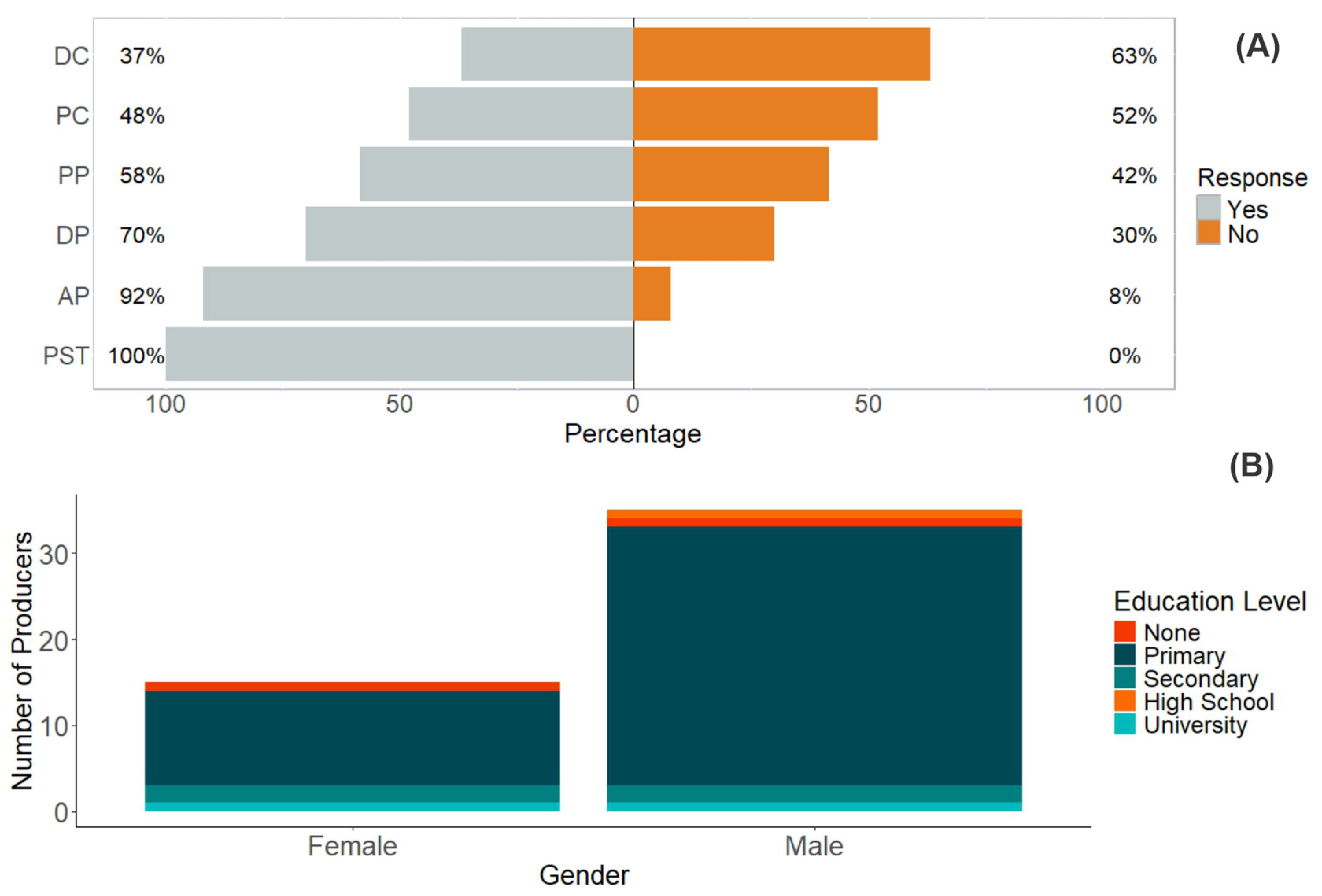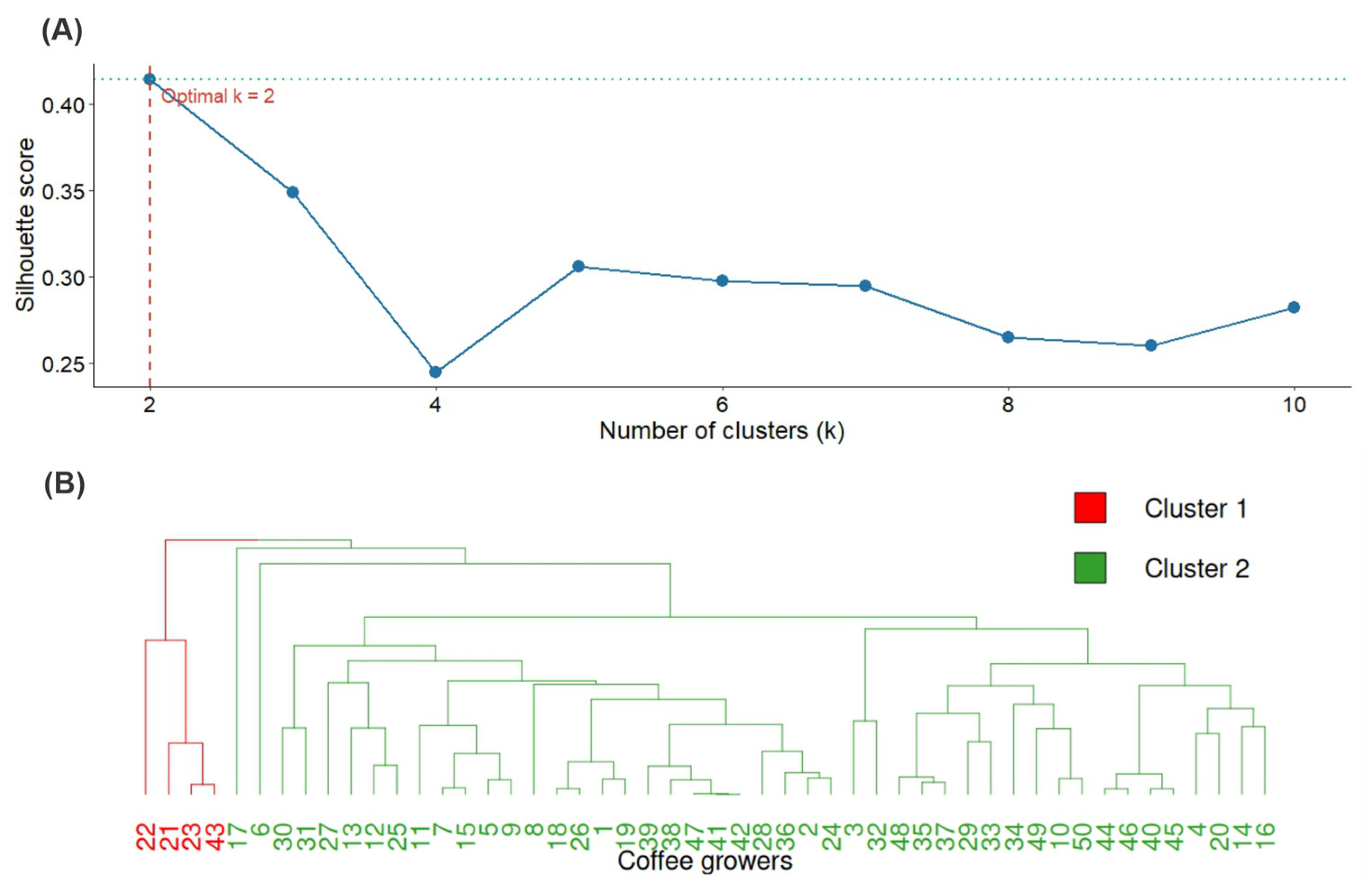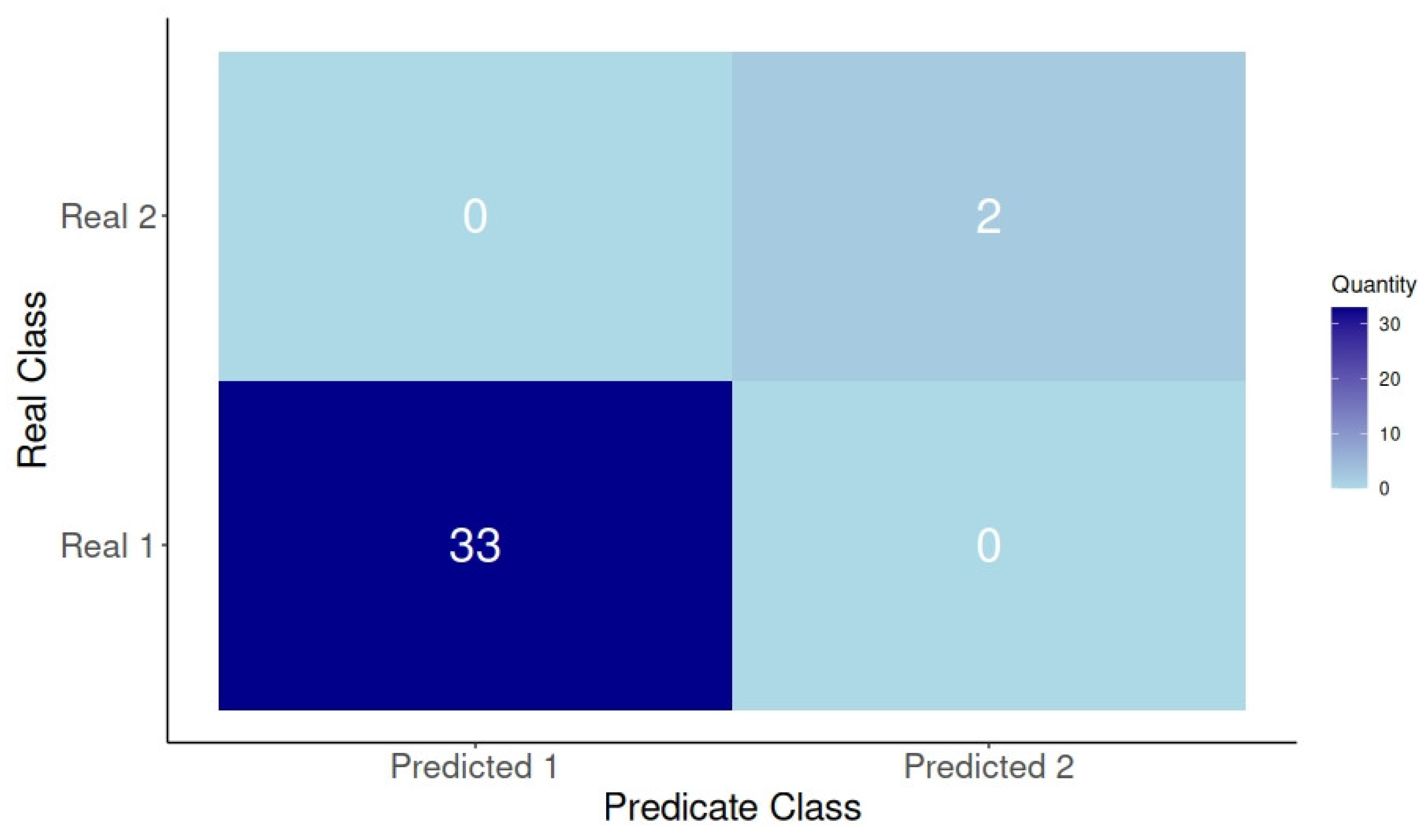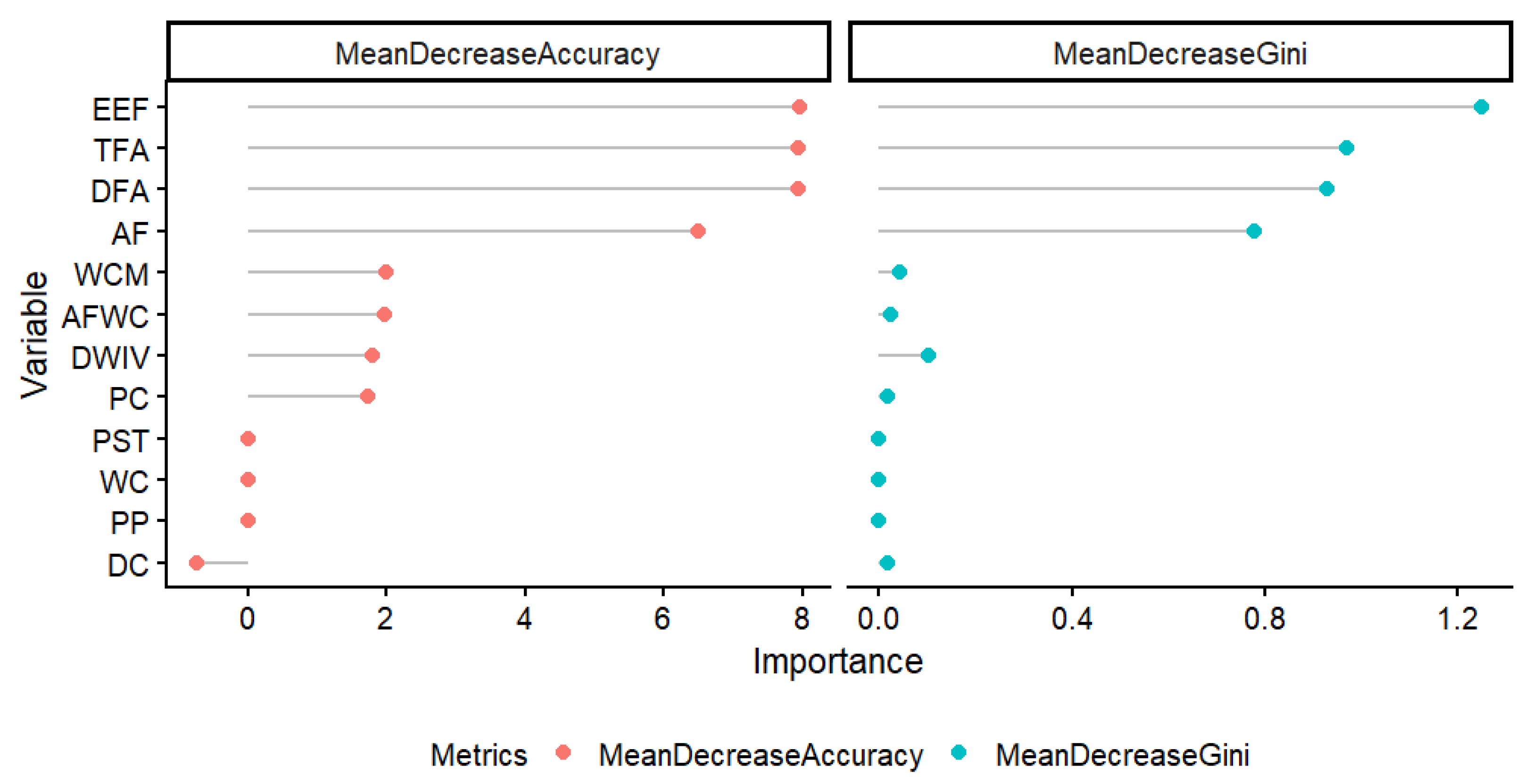Coffee Farming in the Sierra Norte Region of Puebla, Mexico: A Multivariate Analysis Approach to Productive Dedication
Abstract
1. Introduction
2. Materials and Methods
2.1. Study Site
2.2. Population and Selection Strategy
2.3. Data Analysis
Sociodemographic and Agricultural Characteristics of Coffee Growers
2.4. Identification of Homogeneous Groups
Factors Determining Productive Dedication Profiles
2.5. Statistical Analysis
3. Results
3.1. Sociodemographic and Agricultural Characteristics of Coffee Growers
Identification of Homogeneous Groups
3.2. Determining Factors in Productive Dedication Profiles
4. Discussion
5. Conclusions
Supplementary Materials
Author Contributions
Funding
Institutional Review Board Statement
Informed Consent Statement
Data Availability Statement
Acknowledgments
Conflicts of Interest
References
- Quadra, G.R.; Paranaíba, J.R.; Vilas-Boas, J.; Roland, F.; Amado, A.M.; Barros, N.; Dias, R.J.P.; Cardoso, S.J. A global trend of caffeine consumption over time and related-environmental impacts. Environ. Pollut. 2020, 256, 113343. [Google Scholar] [CrossRef]
- Vegro, C.L.R.; Almeida, L.F. Global coffee market: Socio-economic and cultural dynamics. In En Coffee Consumption and Industry Strategies in Brazil; Elsevier: Amsterdam, The Netherlands, 2020; pp. 3–19. [Google Scholar] [CrossRef]
- Secretaría de Agricultura y Desarrollo Rural (SADER). Cultivo de café en México. Gobierno de México. 2022. Available online: https://www.gob.mx/agricultura/articulos/cultivo-de-cafe-en-mexico (accessed on 2 July 2025).
- Servicio de Información Agroalimentaria y Pesquera (SIAP). Avance de Siembras y Cosechas 2024. SIAP. 2024. Available online: https://www.gob.mx/siap (accessed on 2 July 2025).
- Secretaría de Agricultura y Desarrollo Rural (SADER). Café Poblano: Orgullo Nacional. Gobierno de México. 2024. Available online: https://www.gob.mx/agricultura/puebla/articulos/cafe-poblano-orgullonacional (accessed on 2 July 2025).
- Instituto Nacional de Estadística y Geografía (INEGI). Sistema de Cuentas Nacionales de México. INEGI. 2020. Available online: https://cuentame.inegi.org.mx/monografias/informacion/pue/economia/pib.aspx?tema=me&e=21 (accessed on 2 July 2025).
- Morales-Ramos, V.; Escamilla-Prado, E.; Muñoz-Rodríguez, M.; Velásquez-Morales, J.A.; Spinoso-Castillo, J.L. Perfiles de calidad del café de México, 1st ed.; Colegio de Postgraduados en Ciencias Agrícolas: Texcoco, Mexico, 2021. [Google Scholar]
- Basurto, F.; Mapes, C.; Escobar, T.; González, J.C. Ethnobotany of the Sierra Norte de Puebla. In En Ethnobotany of the Mountain Regions of Mexico; Springer International Publishing: Berlin/Heidelberg, Germany, 2022; pp. 1–29. [Google Scholar]
- Villegas Loeza, D. Efectos de la liberalización de la economía en la caficultura: Estudio de caso en la Sierra Norte de Puebla, México. Política Y Cult. 2019, 52, 39–60. Available online: https://www.redalyc.org/journal/267/26761739001/html/ (accessed on 20 August 2025). [CrossRef]
- Moguel, P.; Toledo, V.M. Biodiversity conservation in traditional coffee systems of Mexico. Conserv. Biol. 1999, 13, 11–21. [Google Scholar] [CrossRef]
- Lugo-Morin, D.R.; Desiderio, E.J.; Fajardo Franco, M.L. Practices and community knowledge of the Sierra Norte de Puebla: The case of coffee, its plagues and diseases. Rev. Investig. Agrar. Y Ambient. 2018, 9, 77–87. [Google Scholar]
- Martínez, M.A.; Evangelista, V.; Basurto, F.; Mendoza, M.; Cruz-Rivas, A. Flora útil de los cafetales en la Sierra Norte de Puebla, México. Rev. Mex. Biodivers. 2007, 78, 15–40. [Google Scholar] [CrossRef]
- Hernández-Castaño, J.; Hebert-Calderón, G.T. Percepción de los efectos del cambio climático y prácticas de adaptación de los caficultores del Estado de Puebla, México. Rev. Bio Cienc. 2023, 10, e1419. [Google Scholar] [CrossRef]
- Rivadeneyra, P.J.I.; Ramírez, V.B. El comercio local del café a raíz de su crisis en la Sierra Norte de Puebla. Rev. Mex. Agronegocios 2006, 10, 1–14. Available online: https://www.redalyc.org/articulo.oa?id=14101807 (accessed on 13 August 2025).
- Barrera, R.A.; Ramírez, G.A.G.; Cuevas, R.V.; Espejel, G.A. Modelos de innovación en la producción de café en la Sierra Norte de Puebla, México. Rev. Cienc. Soc. 2021, 27, 443–458. Available online: https://dialnet.unirioja.es/servlet/articulo?codigo=8081783 (accessed on 9 August 2025).
- Gómez, V.J.; Vásquez, L.A.; Regino, M.J.; Jurado, C.S.N. A review of local-scale agricultural sustainability in the coffee regions of Mexico. Cienc. E Investig. Agrar. 2023, 50, 23–45. [Google Scholar] [CrossRef]
- Goodman, D. The international coffee crisis: A review of the issues. In En Confronting the Coffee Crisis: Fair Trade, Sustainable Livelihoods and Ecosystems in Mexico and Central America; MIT Press: Cambridge, MA, USA, 2008. [Google Scholar] [CrossRef]
- Byrareddy, V.; Kouadio, L.; Mushtaq, S.; Stone, R. Sustainable production of Robusta coffee under a changing climate: A 10-year monitoring of fertilizer management in coffee farms in Vietnam and Indonesia. Agronomy 2019, 9, 499. [Google Scholar] [CrossRef]
- Potvin, C.; Owen, T.C.; Melzi, S.; Beaucage, P. Biodiversity and modernization in four coffee-producing villages of Mexico. Ecol. Soc. 2005, 10, 1–17. Available online: http://www.jstor.org/stable/26267708 (accessed on 11 August 2025). [CrossRef]
- Bhattarai, S.; Alvarez, S.; Gary, C.; Rossing, W.; Tittonell, P.; Rapidel, B. Combining farm typology and yield gap analysis to identify major variables limiting yields in the highland coffee systems of Llano Bonito, Costa Rica. Agric. Ecosyst. Environ. 2017, 243, 132–142. [Google Scholar] [CrossRef]
- Galeana-Pizaña, J.M.; Manson, R.H. Mapping coffee intensification in Mexico: A multivariate spatial analysis approach. Front. Sustain. Food Syst. 2025, 9, 1649756. [Google Scholar] [CrossRef]
- Hernández-Martínez, G.; Manson, R.H.; Hernández, A.C. Quantitative classification of coffee agroecosystems spanning a range of production intensities in central Veracruz, Mexico. Agric. Ecosyst. Environ. 2009, 134, 89–98. [Google Scholar] [CrossRef]
- Wardropper, C. Structural and Financial Constraints for Arabica Coffee Planters. Independent Study Project (ISP) Collection. 2007; Volume 131, pp. 1–47. Available online: https://digitalcollections.sit.edu/isp_collection/131 (accessed on 20 July 2025).
- Saxena, A.; Prasad, M.; Gupta, A.; Bharill, N.; Patel, O.P.; Tiwari, A.; Er, M.J.; Ding, W.; Lin, C.-T. A review of clustering techniques and developments. Neurocomputing 2017, 267, 664–681. [Google Scholar] [CrossRef]
- Dexter, E.; Rollwagen-Bollens, G.; Bollens, S.M. The trouble with stress: A flexible method for the evaluation of nonmetric multidimensional scaling. Limnol. Oceanogr. Methods 2018, 16, 434–443. [Google Scholar] [CrossRef]
- Denisko, D.; Hoffman, M.M. Classification and interaction in random forests. Proc. Natl. Acad. Sci. USA 2018, 115, 1690–1692. [Google Scholar] [CrossRef]
- Pavlo, H.; Svitlana, G.; Nila, K.; Tetiana, H. Using non-metric multidimensional scaling for assessment of regions’ economy in the context of their sustainable development. CEUR Workshop Proc. 2020, 2713, 315–333. Available online: http://ceur-ws.org/Vol-2713/paper35.pdf (accessed on 13 August 2025).
- Peimer, A.W.; Krzywicka, A.E.; Cohen, D.B.; Van den Bosch, K.; Buxton, V.L.; Stevenson, N.A.; Matthews, J.W. National-level wetland policy specificity and goals vary according to political and economic indicators. Environ. Manag. 2017, 59, 141–153. [Google Scholar] [CrossRef]
- López, C.D.; Zuñiga, F.B.; Bautista, H.D.A. Identification of soil properties associated with the peasant perception of the suitability of the land for growing organic coffee: The case of traditional agriculture in the “Mixteca Alta” mountains of Oaxaca, México. Agroecol. Sustain. Food Syst. 2023, 48, 161–182. [Google Scholar] [CrossRef]
- Merlín, U.Y.; Charbonnier, F.; Contreras, H.A.; Herrera, H.O.B.; Soto, P.L. Tipología de estrategias campesinas en la caficultura orgánica de la Sierra Madre de Chiapas. Ecosistemas Y Recur. Agropecu. 2018, 5, 411–423. [Google Scholar] [CrossRef]
- Rosales, M.V.; Martínez, D.J.P.; Osorio, A.F.; López, R.G.; Asiaín, H.A.; Estrella, C.N. Cultural, social and productive aspects used for a typology of coffee producers. Agric. Soc. Y Desarro. 2018, 15, 47–61. [Google Scholar]
- Vázquez, L.P.; Espinoza, A.J.J.; González, M.A.; Guerrero, R.L.A. Characteristics of coffee producers and plantations in the northern region of the state of Chiapas. Rev. Mex. Cienc. Agrícolas 2012, 13, 101–111. [Google Scholar] [CrossRef]
- RStudio Team. RStudio: Integrated Development Environment for, R. RStudio, PBC. 2023. Available online: https://www.rstudio.com/ (accessed on 20 August 2025).
- R Core Team. R: A Language and Environment for Statistical Computing. R Foundation for Statistical Computing. 2024. Available online: https://www.R-project.org/ (accessed on 20 July 2025).
- Maechler, M.; Rousseeuw, P.; Struyf, A.; Hubert, M.; Hornik, K. Cluster: Cluster Analysis Basics and Extensions (R Package Version 2.1.6). CRAN. 2023. Available online: https://CRAN.R-project.org/package=cluster (accessed on 20 July 2025).
- Hennig, C. Fpc: Flexible Procedures for Clustering (R Package Version 2.2-13). CRAN. Available online: https://CRAN.R-project.org/package=fpc (accessed on 13 August 2025).
- Oksanen, J.; Simpson, G.; Blanchet, F.; Kindt, R.; Legendre, P.; Minchin, P.; O’hara, R.B.; Solymos, P.; Stevens, M.H.; Wagner, H. Vegan: Community Ecology Package (R Package Version 2.6-6.1). CRAN. 2024. Available online: https://CRAN.R-project.org/package=vegan (accessed on 20 July 2025).
- Liaw, A.; Wiener, M. Classification and regression by randomForest. R News 2002, 2, 18–22. Available online: https://CRAN.R-project.org/doc/Rnews/ (accessed on 20 July 2025).
- Folch, A.; Planas, J. Cooperation, Fair Trade, and the development of organic coffee growing in Chiapas (1980–2015). Sustainability 2019, 11, 357. [Google Scholar] [CrossRef]
- Gómez Tovar, L.; Martin, L.; Gómez Cruz, M.A.; Mutersbaugh, T. Certified organic agriculture in Mexico: Market connections and certification practices in large and small producers. J. Rural Stud. 2005, 21, 461–474. [Google Scholar] [CrossRef]
- Méndez, V.E.; Bacon, C.M.; Olson, M.; Petchers, S.; Herrador, D.; Carranza, C.; Trujillo, L.; Guadarrama-Zugasti, C.; Cordón, A.; Mendoza, A. Effects of Fair Trade and organic certifications on small-scale coffee farmer households in Central America and Mexico. Renew. Agric. Food Syst. 2010, 25, 236–251. [Google Scholar] [CrossRef]
- Rocha-Rodríguez, C.; Mora-Delgado, J.; Romero-Vargas, J.C. Tipología de sistemas de producción en la zona rural del municipio de Ibagué, Colombia. Agron. Mesoam. 2016, 27, 253–264. [Google Scholar] [CrossRef]
- Angnes, G.; Martello, M.; Faulin, G.D.C.; Molin, J.P.; Romanelli, T.L. Energy efficiency of variable rate fertilizer application in coffee production in Brazil. AgriEngineering 2021, 3, 815–826. [Google Scholar] [CrossRef]
- de Souza, T.L.; de Oliveira, D.P.; Santos, C.F.; Reis, T.H.P.; Cabral, J.P.C.; da Silva Resende, É.R.; Fernandes, T.J.; de Souza, T.R.; Builes, V.R.; Guelfi, D. Nitrogen fertilizer technologies: Opportunities to improve nutrient use efficiency towards sustainable coffee production systems. Agric. Ecosyst. Environ. 2023, 345, 108317. [Google Scholar] [CrossRef]
- Sarkis, L.F.; Dutra, M.P.; dos Santos, C.A.; Rodrigues Alves, B.J.; Urquiaga, S.; Guelfi, D. Nitrogen fertilizers technologies as a smart strategy to mitigate nitrous oxide emissions and preserve carbon and nitrogen soil stocks in a coffee crop system. Atmos. Environ. X 2023, 20, 100224. [Google Scholar] [CrossRef]
- Secretaría de Agricultura y Desarrollo Rural (SADER). Conoce el Programa Fertilizantes para el Bienestar. Gobierno de México. Febrero. 2024. Available online: https://www.gob.mx/agricultura/articulos/conoce-el-programa-fertilizantes-para-el-bienestar?idiom=es (accessed on 3 July 2025).
- Bravo-Monroy, L.; Potts, S.G.; Tzanopoulos, J. Drivers influencing farmer decisions for adopting organic or conventional coffee management practices. Food Policy 2016, 58, 49–61. [Google Scholar] [CrossRef]
- Gokavi, N.; Mote, K.; Jayakumar, M.; Raghuramulu, Y.; Surendran, U. The effect of modified pruning and planting systems on growth, yield, labour use efficiency and economics of Arabica coffee. Sci. Hortic. 2021, 276, 109764. [Google Scholar] [CrossRef]
- Soto-Pinto, L.; Perfecto, I.; Castillo-Hernandez, J.; Caballero-Nieto, J. Shade effect on coffee production at the northern Tzeltal zone of the state of Chiapas, Mexico. Agric. Ecosyst. Environ. 2000, 80, 61–69. [Google Scholar] [CrossRef]
- Pérez-Vázquez, A.; Pérez-Sánchez, O.; Lango-Reynoso, V.; Escamilla-Prado, E. El agroecosistema cafetalero: Policultivo tradicional versus policultivo comercial en Chocamán, Veracruz. Rev. Mex. Cienc. Agrícolas 2024, 15, e3248. [Google Scholar] [CrossRef]
- Ngeywo, J.; Basweti, E.; Shitandi, A. Influence of gender, age, marital status and farm size on coffee production: A case of Kisii County, Kenya. Asian J. Agric. Ext. Econ. Sociol. 2015, 5, 117–125. [Google Scholar] [CrossRef] [PubMed]
- Sumarti, T.; Falatehan, S.F. The role and position of young coffee farmers: The gap between generations in the coffee business. Agric. Agric. Sci. Procedia 2016, 9, 500–509. [Google Scholar] [CrossRef]
- Azibo Balgah, R.; Balgah, R.A. Factors influencing coffee farmers’ decisions to join cooperatives. Sustain. Agric. Res. 2019, 8, 42–58. [Google Scholar] [CrossRef]
- Clément, R.; Tuan, D.; Cuong, V.; Le Van, B.; Trung, H.Q.; Long, C.T.M. Transitioning from monoculture to mixed cropping systems: The case of coffee, pepper, and fruit trees in Vietnam. Ecol. Econ. 2023, 214, 107980. [Google Scholar] [CrossRef]
- Griffith, D.; Zamudio Grave, P.; Cortés Viveros, R.; Cabrera Cabrera, J. Losing labor: Coffee, migration, and economic change in Veracruz, Mexico. Cult. Agric. Food Environ. 2017, 39, 35–42. [Google Scholar] [CrossRef]
- Martínez-Reina, A.M.; Araujo, H.; Regino, S.M.; Espitia, A.; Tordecilla, L.; Grandett, L.; Pérez, S.; Martínez, R.; Rosero, A. Farmers’ typologies for the construction of a technological and socioeconomic baseline of industrial cassava organizations to guide research, production, and policy design in the Colombian Caribbean region. Agriculture 2025, 15, 488. [Google Scholar] [CrossRef]
- Niftiyev, I.; Ibadoghlu, G. Longitudinal principal component and cluster analysis of Azerbaijan’s agricultural productivity in crop commodities. Commodities 2023, 2, 147–167. [Google Scholar] [CrossRef]
- Siogkas, T.; Melfou, K.; Koutouzidou, G.; Loizou, E.; Ragkos, A. Structural analysis of farming systems in Western Macedonia: A cluster-based approach. Agriculture 2025, 15, 1650. [Google Scholar] [CrossRef]







| Variable | Variable Types and Units of Measurement | Acronym |
|---|---|---|
| 1 | Economic expenditure of fertilization (MXN) | EEF |
| 2 | Applies fertilization (Si/No) | AF |
| 3 | Daily wages invested per cycle (NUM) | DWIV |
| 4 | Type of fertilization applied (Soil, Foliar, Both) | TFA |
| 5 | Division of fertilization application (Yes/No) | DFA |
| 6 | Pruning performed (Yes/No) | PP |
| 7 | Pruning of shade trees (Yes/No) | PST |
| 8 | Pest control (Yes/No) | PC |
| 9 | Disease control (Yes/No) | DC |
| 10 | Weed control (Yes/No) | WC |
| 11 | Annual frequency of weed control | AFWC |
| 12 | Weed control method (Chemical, Manual, Both) | WCM |
| Handling Characteristics | Cluster 1 (n = 4, 8%) | Cluster 2 (n = 46, 92%) |
|---|---|---|
| Fertilization | Not applied | Applied (different types and split application) |
| Economic expenditure | Limited | High |
| Labor per cycle | Reduced | Higher number (sanitation, fertilization, pruning) |
| Pruning | Incomplete | More complete application |
| Pest and disease control | Do not report | Yes, more frequently |
| Atypical cases | Do not report | Two producers with internal variations (6 y 17) |
Disclaimer/Publisher’s Note: The statements, opinions and data contained in all publications are solely those of the individual author(s) and contributor(s) and not of MDPI and/or the editor(s). MDPI and/or the editor(s) disclaim responsibility for any injury to people or property resulting from any ideas, methods, instructions or products referred to in the content. |
© 2025 by the authors. Licensee MDPI, Basel, Switzerland. This article is an open access article distributed under the terms and conditions of the Creative Commons Attribution (CC BY) license (https://creativecommons.org/licenses/by/4.0/).
Share and Cite
Rodríguez-Flores, Z.E.; San-Martín-Hernández, C.; Morales-Ramos, V.; Volke-Haller, V.H.; Padilla-Cuevas, J.; Hernández-Gómez, C. Coffee Farming in the Sierra Norte Region of Puebla, Mexico: A Multivariate Analysis Approach to Productive Dedication. Agriculture 2025, 15, 2192. https://doi.org/10.3390/agriculture15212192
Rodríguez-Flores ZE, San-Martín-Hernández C, Morales-Ramos V, Volke-Haller VH, Padilla-Cuevas J, Hernández-Gómez C. Coffee Farming in the Sierra Norte Region of Puebla, Mexico: A Multivariate Analysis Approach to Productive Dedication. Agriculture. 2025; 15(21):2192. https://doi.org/10.3390/agriculture15212192
Chicago/Turabian StyleRodríguez-Flores, Zayner Edin, Cesar San-Martín-Hernández, Victorino Morales-Ramos, Victor Hugo Volke-Haller, Juliana Padilla-Cuevas, and Carlos Hernández-Gómez. 2025. "Coffee Farming in the Sierra Norte Region of Puebla, Mexico: A Multivariate Analysis Approach to Productive Dedication" Agriculture 15, no. 21: 2192. https://doi.org/10.3390/agriculture15212192
APA StyleRodríguez-Flores, Z. E., San-Martín-Hernández, C., Morales-Ramos, V., Volke-Haller, V. H., Padilla-Cuevas, J., & Hernández-Gómez, C. (2025). Coffee Farming in the Sierra Norte Region of Puebla, Mexico: A Multivariate Analysis Approach to Productive Dedication. Agriculture, 15(21), 2192. https://doi.org/10.3390/agriculture15212192







